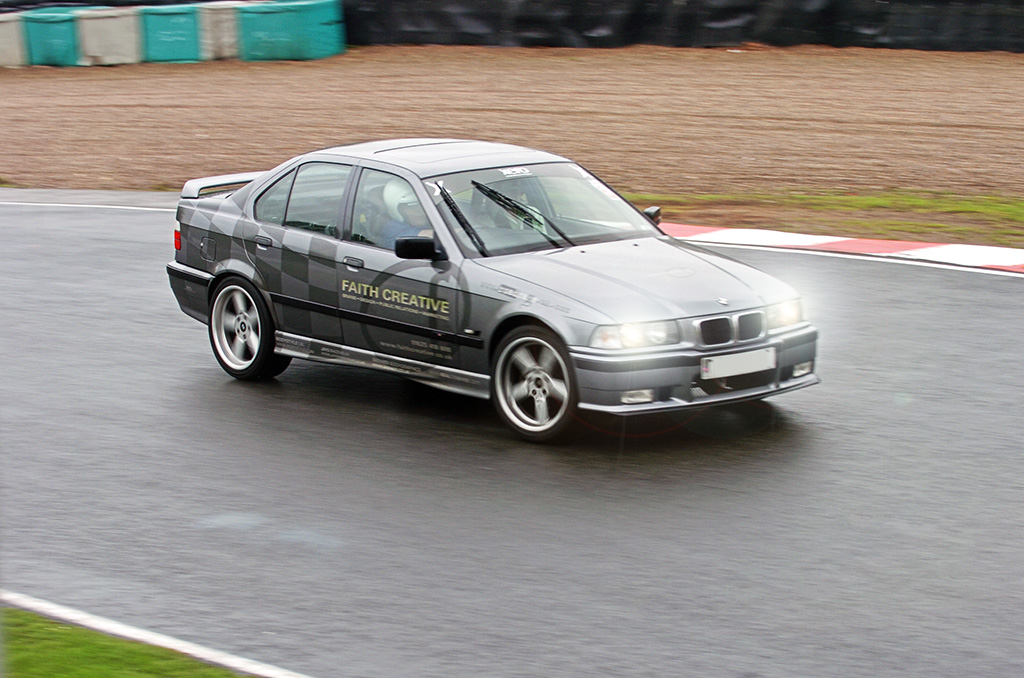HOW TO STEER
Like all control inputs when driving, the steering inputs should be smooth and progressive. To achieve this it is first necessary to hold the steering wheel in the correct way. It may come as a surprise to many that the best and most appropriate technique for holding and controlling the steering wheel is almost completely the opposite of what you are taught when you are learning to drive and indeed what is required to pass your driving test.
THIS IS ME DRIFTING A BMW THROUGH LODGE CORNER AT OULTON PARK - NOTICE MY ARMS ARE CROSSED - THERE'S NO WAY I'D HAVE HELD THIS IF I DID THE BSM SHUFFLE!
The technique of ‘feeding the wheel’ with the ‘push and pull’ method taught by driving schools and required by examiners, which we motor sport instructors mockingly refer to as the ‘BSM (British School of Motoring) Shuffle’ is antiquated and inadequate for proper control in modern [including road] cars. And by modern I mean later than the early 1960’s.
The push and pull technique dates back to days when cars had much larger steering wheels and low geared steering racks or boxes. Modern cars have smaller steering wheels, higher geared steering racks and (in many cases) power steering. Using the push / pull technique is slow, jerky and counter-intuitive.
The correct way to hold and control a steering wheel is to keep your hands in a fixed position at ‘quarter-to-three’ on the wheel with a light but firm grip and ‘roll’ it, crossing your hands if necessary.
Here’s why keeping your hands in a fixed position and rolling the steering wheel is the correct way:
- Control – you have far better control of the wheel.
- Smooth – steering inputs are much smoother.
- Accuracy – you have a much better ‘connection’ with the road wheels and always know which way they are pointing.
- Speed – not road speed but the speed that your steering inputs including corrections can be applied and controlled.
As an example let’s look at a scenario where things go out of control. You’re negotiating a roundabout on a wet day and unknown to you a lorry has spilt some diesel on the road making it extremely slippery. The first you know about it is your front wheels lose grip and the steering gets lighter, then your rear wheels lose grip as they reach the diesel and you find yourself in a skid…
Most people will naturally steer into the skid, but how much and how quickly will have a huge impact on whether you actually regain control of the car. If your car suddenly and unexpectedly goes into a skid there is very little chance that you can put in the correct amount of corrective steering fast enough and accurately enough to recover. If however by some fluke you do manage it and the rear tyres suddenly regain their grip on the road, your chances of removing the corrective lock quickly enough and returning the wheel to its original position quickly enough are remote, and the most likely outcome is the car spinning off in the opposite direction.
IN THIS VIDEO I’M DRIVING A HISTORIC FORMULA FORD RACING CAR ON A DAMP SNETTERTON CIRCUIT IN DRIZZLE. I’VE USED THIS AS AN EXAMPLE BECAUSE IT DEMONSTRATES HOW QUICKLY AND ACCURATELY CORRECTIONS NEED TO BE APPLIED AND REMOVED AND CONTROL CAN ONLY BE MAINTAINED BY USING THE STEERING TECHNIQUE I HAVE DESCRIBED. OBVIOUSLY THIS IS A RACING CAR AND IT IS TRAVELLING FASTER THAN MOST ROAD CARS WOULD, WHICH EXAGGERATES EVERYTHING, BUT THE DYNAMICS AND THE CORRECT DRIVING TECHNIQUES ARE THE SAME. THE QUALITY OF THE VIDEO ISN'T GREAT UNFORTUNATELY.
In road driving, at slow speeds, manoeuvring in tight spaces and parking, it’s perfectly ok, more efficient and better to spin the wheel with one hand whether with fingertips or ‘palming’ it.
For all other driving, unless it’s impossible in some circumstances (which is unlikely), keep your hands fixed in the quarter-to-three position on the wheel and roll the wheel smoothly and progressively.
To quote a friend of mine, Ben (The Stig from Top Gear) Collins commenting on his book 'How To Drive' compared to the Highway Code:
"It’s The Stig’s version of the Highway Code,“ he laughs. “The Code is extremely valuable, but there are some things in there that are outdated, like braking distances, and even the basics of how to turn the wheel. The way I recommend is diametrically opposed to the way we’re taught. The shuffle steering technique was set up in 1935 for the police back when cars had steering wheels that were the size of yachts’ – pushing and pulling was the only way to turn them. Now we have power steering, you don’t need to do that. You can be far more accurate by holding your hands at quarter to three on the wheel and you’re much better positioned to control a skid."
If you need further clarification, call me on: 07800 715450, Tim




